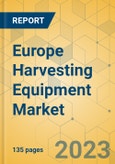Speak directly to the analyst to clarify any post sales queries you may have.
KEY HIGHLIGHTS
- Europe has over 749 million food consumers. The agriculture sector plays a vital role in the development of the economy. Developed economies focus on agriculture as food self-sufficiency is the critical agenda for any economy to flourish.
- The emphasis on export-centric production and related returns by exporting significant, high-quality products will boost the sales of new harvesting equipment and agriculture equipment in the Europe harvesting equipment market to fulfill the required farming activities.
- With the share of agricultural exports growing slowly, some governments, such as Germany, France, and the UK, are working to double the quantity and revenues from agricultural product exports by 2030.
- The Europe harvesting equipment market grew by 2.7% in 2022 from 2021. The increase in crop production and harvesting equipment sales was due to a favorable climate in 2021 and 2022.
- Most of the government plans schemes and initiatives to facilitate credit and improve agriculture-related operations, which will contribute to the growth of the overall value chain of the Europe harvesting equipment industry.
INSIGHTS BY HARVESTER TYPE
The combined harvester segment generated the highest sales in almost all the countries of Europe. It dominated the European harvesting equipment market due to its efficiency, labor-saving capabilities, versatility for diverse crops, precision agriculture integration, and the need to meet increasing food demands efficiently. Combines have revolutionized the harvesting process, allowing farmers to efficiently and effectively collect large quantities of crops. They continue to evolve with advancements in technology, automation, and data management, contributing to improving agricultural practices and overall productivity.Segmentation by Harvester Type
- Combine
- Forage
REGIONAL ANALYSIS
Germany has the highest demand for harvesting equipment across Europe. Agriculturally developed countries like France and Germany are characterized by medium-scale farms and intensive farming practices. The high level of farm mechanization demands technologically advanced harvesters. Farmers in such geographies use connected technology systems and precision agriculture implements, which drive the demand for innovative or advanced harvesters. One more characteristic of these regions is that large or combined harvesters are standard on large-scale farms.Segmentation by Geography
- Germany
- France
- The U.K.
- Poland
- Spain
- Others
VENDOR LANDSCAPE
The Europe harvesting equipment market is moderately fragmented, with many local and international players. Changes in the economic environment may harm vendors as consumers expect constant advances and upgrades in agricultural equipment. The current situation pushes vendors to adjust and improve their value proposition to attain a good business presence. Claas, New Holland, John Deere, Case IH, and Fendt are among the major vendors in the Europe harvesting equipment industry. Prominent entities like Deere & Company, CNH Industrial, CLAAS, and AGCO Corporation have embraced strategies involving introducing innovative products and making strategic investments to propel their industry presence.Recent Developments in the Europe Harvesting Equipment Market
- In March 2023, John Deere announced MY24 updates for its 7, 8, and 9 Series Tractors lineup that will help prepare them for the future of precision agriculture.
- AGCO launched the latest Fendt 700 Vario series tractors in August 2022, featuring an upgraded powertrain with VarioDrive transmission and Fendt iD low engine speed concept. This new generation aims to enhance efficiency and productivity for customers.
Key Company Profiles
- CLAAS
- John Deere
- CNH Industrial
- AGCO
- Kubota
Other Prominent Vendors
- Grimme
- SDF
- Krone
- KUHN Group
- Yanmar
WHY SHOULD YOU BUY THIS REPORT?
This report is among the few in the market that offer outlook and opportunity analyses forecast in terms of:
- Market Size & Forecast Volume 2020-2028 (Units)
I.
II.
- Major current and upcoming projects and investments
- Competitive intelligence about the economic scenario, advantages, and benefits of harvesters, industry dynamics, and industry shares
- Latest and innovative technologies
- Import and export analysis
- Company profiles of major and other prominent vendors
KEY QUESTIONS ANSWERED:
1. What are the expected units sold in the Europe harvesting equipment market by 2028?2. What is the growth rate of the Europe harvesting equipment market?
3. How big is the European harvesting equipment market?
4. Which region holds the largest Europe harvesting equipment market share?
5. Who are the key companies in the Europe harvesting equipment market?
Table of Contents
Companies Mentioned
- CLAAS
- John Deere
- CNH Industrial
- AGCO
- Kubota
- Grimme
- SDF
- Krone
- KUHN Group
- Yanmar
Methodology
Our research comprises a mix of primary and secondary research. The secondary research sources that are typically referred to include, but are not limited to, company websites, annual reports, financial reports, company pipeline charts, broker reports, investor presentations and SEC filings, journals and conferences, internal proprietary databases, news articles, press releases, and webcasts specific to the companies operating in any given market.
Primary research involves email interactions with the industry participants across major geographies. The participants who typically take part in such a process include, but are not limited to, CEOs, VPs, business development managers, market intelligence managers, and national sales managers. We primarily rely on internal research work and internal databases that we have populated over the years. We cross-verify our secondary research findings with the primary respondents participating in the study.

LOADING...
Table Information
| Report Attribute | Details |
|---|---|
| No. of Pages | 135 |
| Published | October 2023 |
| Forecast Period | 2022 - 2028 |
| Estimated Market Value in 2022 | 8301 Units |
| Forecasted Market Value by 2028 | 10056 Units |
| Compound Annual Growth Rate | 3.2% |
| Regions Covered | Europe |
| No. of Companies Mentioned | 10 |








